A Different NATO
 |
NATO is more complex today than in years past. “Cyber” has appeared for the first time in the NATO lexicon in the recently published alliance strategy document. Also, only in recent years has NATO been engaged actively in directing combat operations. The alliance has 28 member nations today, which represents a significant increase from the 16 members of the Cold War days. This growth not only has added significant capability to the alliance, but it also has made every aspect of NATO planning and execution more difficult because NATO largely is a consensus alliance. It is no coincidence that the NC3A is the NATO Consultation, Command and Control Agency.
Industry interface with NATO always has been challenging. This is because the organization is complex and because, while most of the procurement is accomplished through the NATO agencies, funding largely comes from member nations. Some of this will be streamlined in the command, control, communications, computers, intelligence, surveillance and reconnaissance (C4ISR) and information technology space. This is because most of the procurement for the force structure will be accomplished through the new NC3A and the NATO Communication and Information Systems (CIS) Services Agency (NCSA). In spite of this streamlining, NATO C4ISR will continue to be a complex environment, and priorities will change with the new strategic plan and the restructuring.
To help everyone understand all the changes and how to best support NATO going forward, AFCEA has partnered with the NC3A to present an industry day and conference October 19-21, 2011, at the Kongresshaus in the Stadthalle, Heidelberg, Germany. The first day and a half will be devoted to NC3A Industry Day, outlining the procurement prospects going forward under the new plan. This will be an important opportunity to learn about future NC3A programs and to hear from the contracting, procurement and program management leaders who will participate.
The second day and a half will be devoted to the AFCEA TechNet International Conference, conducted under the auspices of State Secretary Rüdiger Wolf, Ministry of Defense, Federal Republic of Germany. The conference will focus on the NATO restructuring and how the community can best support NATO as it executes its goals over the next decade. Senior leaders from the German Bundeswehr, NATO staff, NATO Military Committee, NC3A, NCSA, NATO Maintenance and Supply Agency (NAMSA), Supreme Allied Command Transformation (SACT), U.S. and European industry, and others will speak at this symposium. The broad set of perspectives will ensure a comprehensive understanding of NATO’s current status, the implications of the restructuring and how NATO will evolve over the next decade.
The entire three days will be interactive, offering the opportunity for a real dialogue to discuss issues of interest to the diverse attendees. In addition, government and industry will be able to exhibit the full three days, allowing ample time for information exchange among government, industry and academia. Given the new environment in NATO, this exchange among all elements of the C4ISR and information technology communities will be very important. It will give government a view of solutions in the product and services areas, and it will help industry understand near- and mid-term requirements from government.
One last thought on this restructuring: Given that the NATO leadership is finishing up the planning for this massive undertaking, this three-day coupling of the NC3A Industry Day and AFCEA TechNet International Conference provides an opportunity for industry to provide some feedback that may be very useful to the NATO leaders as they move into execution. Don’t miss the opportunity to be part of that dialogue.
And this interaction with NATO leadership need not be limited to the symposium. This year, AFCEA is presenting its highest honor, the David Sarnoff Award, to Adm. James Stavridis, USN, commander, U.S. European Command and Supreme Allied Commander Europe. Those involved with NATO and U.S. Forces in Europe will have an additional opportunity to interface with Adm. Stavridis at the Sarnoff Award Dinner on September 14, 2011, at the Willard Hotel in Washington, D.C. Don’t miss these two events.
I look forward to seeing many of you in Heidelberg October 19-21 as we explore how better to support NATO going forward. As always, thanks for all you do for the global security community and AFCEA.




Comments